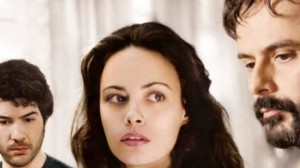 CANNES, France � By Thursday afternoon at the film festival here, over glasses of C�tes de Provence, the battle lines had been firmly drawn and the Palme d�Or hypothetically awarded. The winner, amateur prognosticators huddling in the festival headquarters confidently or cautiously predicted, surely would be �Inside Llewyn Davis� or �The Great Beauty� or �Blue Is the Warmest Color� or �Nebraska.� Never mind that it was only Day 9 and that the actual awards don�t take place until Sunday evening. For many, the 66th�Cannes Film Festival�was leveling off toward another grand finale.
CANNES, France � By Thursday afternoon at the film festival here, over glasses of C�tes de Provence, the battle lines had been firmly drawn and the Palme d�Or hypothetically awarded. The winner, amateur prognosticators huddling in the festival headquarters confidently or cautiously predicted, surely would be �Inside Llewyn Davis� or �The Great Beauty� or �Blue Is the Warmest Color� or �Nebraska.� Never mind that it was only Day 9 and that the actual awards don�t take place until Sunday evening. For many, the 66th�Cannes Film Festival�was leveling off toward another grand finale.The latest from�Alexander Payne, the warmly if not ardently received �Nebraska,� had its first press screening on Thursday morning. Will Forte stars as David Grant, a Montana salesman whose seemingly fading father, Woody (Bruce Dern), believes he has won $1 million from a marketing company in Nebraska. After Woody keeps going dangerously AWOL � no longer able to drive, he tries to walk to Nebraska in the cold to claim his prize � David decides to drive him. David wants to placate his father, and perhaps spend some time with a man whose alcoholism has made him a less than ideal parent. The setup also puts Mr. Payne back on the road, a physical and existential space that has served him well in films like��Sideways��and�About Schmidt.�
Written by Bob Nelson, �Nebraska� opens modestly with two men in a car and grows progressively larger to encompass a family, a small town of the kind rarely seen in American cinema and a specific moment in time. Mr. Payne takes a bit too long to get the movie into gear, but eventually David and Woody end up in a Nebraska town where they endure a sometimes funny, sometimes painful reunion with relatives and old (and elderly) friends. Shooting in black and white that is as simple, unfussy and unbeautiful as the modest homes in the movie, Mr. Payne draws an emotionally vivid, insistently unsentimentalized portrait of America and forgotten men, like a farmer who was destroyed by working his farm and a war veteran who returned with wounds he never discussed.
As is his way, Mr. Payne maintains an amused, ironic distance from his characters that may feel as if he�s condescending to them but is more truly an acknowledgment of life�s absurdity. The characters in �Nebraska� are at times ridiculous. They�re also warm, cruel, generous, selfish � in other words, recognizably human.
And while the movie largely hinges on David and Woody, its most vivid performances are from two character actresses: Angela McEwan delivers a flawlessly calibrated wistful performance as a newspaper editor who knows more about Woody than his son does, while June Squibb turns Woody�s hectoring, quietly complicated wife, Kate, into a minor miracle. Mr. Payne makes her a saving grace.
If the end of the festival feels muted this year, it�s partly because no single title has yet overwhelmed festivalgoers the way Michael Haneke�s �Amour,� which won the Palme last year, did. That�s the case even if there have been favorites like �Inside Llewyn Davis,� the latest from Joel and Ethan Coen. One index of the love it�s received can be found in the critical rankings that appear daily in the industry magazines Screen and Le Film Fran�ais, which festivalgoers pore over while waiting for the 8:30 a.m. competition screenings to begin. (Wifi service is expensive and unreliable.) In Screen, �Llewyn Davis� earned 3.3 out of 4 stars from the mostly British critics, the top rating so far; at Le Film Fran�ais, the French critics were especially high on �Le Pass� (�The Past�).
Directed by the Iranian filmmaker Asghar Farhadi, �Le Pass� � much like his last film, �A Separation� � turns on several knotted relationships. This one involves Ahmad (Ali Mosaffa), who, when the movie opens, has just arrived in Paris from Iran. Years after separating, his estranged French wife, Marie (B�r�nice Bejo, from �The Artist�), has asked him to return to his former home so that they can finalize their divorce. Waiting in the wings is her lover, Samir (Tahar Rahim, from �A Prophet�), who has a young son and a comatose wife. Although the story edges toward soap-opera banality, the acting and a visual style, which is at once complex and restrained � Mr. Farhadi moves his camera and people through space beautifully, making rooms come alive � elevates the material.
However provisional and ostensibly vulgar, the rankings allow critics to check in on one another and give distributors another chance, along with Twitter feeds and blogs, to take a temperature reading. Cannes isn�t just an important critical jamboree, it�s also one of the most important, best publicized markets in the festival world. Held in conjunction with the official festival, Le March� du Film runs parallel with the festival, though it starts to close down midway through.
The market�s numbers suggest the scale and stakes: last year, 4,912 companies from 102 countries participated, attracting 11,481 registered attendees who were able to sample 903 films. Most of the figures for this year aren�t in, but United States participation is apparently up 7 percent, Screen reported, and American sales have been brisk.
This is good news for American moviegoers, especially those who venture beyond the multiplex. Sony Classics Pictures picked up �Le Pass� at Cannes, for instance, one of a number of acquisitions that will give hope to those weary of the usual parade of big-studio sequels and cartoons. American distribution also seems inevitable for Luc�a Puenzo�s �Wakolda� (playing in the festival section called Un Certain Regard), a creepy, commercial thriller from Argentina about Nazis hiding in Patagonia in 1960, which will play as well in regional film festivals as in theaters. Working from her own novel, also titled �Wakolda,� Ms. Puenzo � who was last at Cannes with the coming-of-age story �XXY� � creates an eerie world of family secrets and state lies that grows increasingly scary when it emerges that a friendly stranger may be Josef Mengele.
�The Great Beauty� (�La Grande Bellezza�), an outlandishly entertaining hallucination from the Italian director�Paolo Sorrentino, will also have a sustained life on the festival circuit and should eventually make it to American theaters. A contemporary riff on �La Dolce Vita,� among other cinematic and literary touchstones, it stars a fantastic Toni Servillo as Jep Gambardella, a Rome journalist. After enjoying early success as a novelist, Jep has settled into � or perhaps for � an existence of rotating pleasures and unending parties, ravishingly beautiful women and lavishly prepared meals. A sensualist of rarefied taste and sensibility, he leads a life that is at once empty and overflowing and that, much like Mr. Sorrentino�s fluid moving cameras and people, moves to the insistent beat of life.
The camera and its misuses in the well-regarded French entry �Blue Is the Warmest Color� (�La Vie d�Ad�le Chapitres 1 et 2�) could fill pages. Directed by�Abdellatif Kechicheand based on�Julie Maroh�s�graphic novel �Blue Angel,� the movie was one of the more hotly anticipated competition titles in more than one sense. Before the screening, word swirled that it featured a 20-minute lesbian sex scene and one male critic overshared, if in more colorful language, that he had been told it was an onanistic fete. More pragmatically, this wildly undisciplined, overlong 2-hour, 59-minute drama tracks the sentimental education of its heroine, Ad�le (Ad�le Exarchopoulos), from 15 through her 20s and her life-changing love for another woman, Emma (L�a Seydoux).
The two meet by chance, first passing each other in the street � the effect Emma has on Ad�le, then a high-school junior, is electric � and then in a bar. Although Emma has a lover, who conveniently disappears, she and Ad�le become lovers. An hour and a half after the start, the two are tumbling in bed and while I didn�t clock their initial encounter, it goes on so long that a male friend jokingly complained about glancing at his watch.
In this scene, as throughout, Mr. Kechiche and his hand-held camera keep close tabs on Ad�le. This intimacy is clearly meant to draw you into her consciousness. Yet, as the camera hovers over her open mouth and splayed body, even while she sleeps with her derri�re prettily framed, the movie feels far more about Mr. Kechiche�s desires than anything else.
It�s disappointing that Mr. Kechiche, whose movies include �The Secret of the Grain� and �Black Venus� (another voyeuristic exercise), seems so unaware or maybe just uninterested in the tough questions about the representation of the female body that feminists have engaged for decades. However sympathetic are the characters and Ms. Exarchopoulos, who produces prodigious amounts of tears and phlegm along with some poignant moments, Mr. Kechiche registers as oblivious to real women. He�s as bad as the male character who prattles on about �mystical� female orgasms and art without evident awareness of the barriers female artists faced or why those barriers might help explain the kind of art, including centuries of writhing female nudes, that was produced.
�Men look at women,� the art critic John Berger observed in 1972. �Women watch themselves being looked at.� Plus �a change....
By The New York Times
The Iran Project is not responsible for the content of quoted articles.










